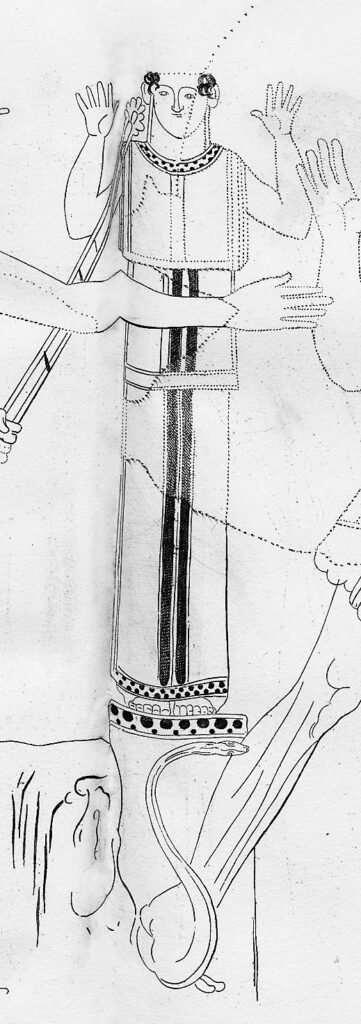2021.08.09 | By Gregory Nagy
§0. The cover illustration for this essay is a drawing, made in the early nineteenth century of our era, which copies with some clarity and flair a picture painted on a vase manufactured in Athens in the fifth century BCE and now housed in Vienna. A follow-up illustration, immediately below the drawing, is a photograph of this ancient painting, and further below is an overall photograph of the vase itself. What we see pictured here is a scene derived from myths about the hero Philoctetes. We see him participating in a sacrifice that took place on an island named Chryse, sacred to a goddess named Chryse, whose cult statue, viewed frontally, is overseeing the sacrifice. This scene will be unfamiliar to readers who are familiar only with the version of the myth of Philoctetes that we see foregrounded by Sophocles in his tragedy named after this hero, Philoctetes, the première of which took place in 411 BCE at the festival of the City Dionysia in Athens. Before I focus on what will be unfamiliar, however, I review here what will seem quite familiar. In the version of Sophocles, as in the version of the myth we see in the picture I show here, Philoctetes was participating in a sacrifice that took place on the island Chryse, sacred to the goddess Chryse. In the version of Sophocles, however, unlike the version we see pictured here, the sacrifice went wrong. A snake guarding the cult statue of the goddess bit Philoctetes in the foot. This toxic wounding of the hero, as I noted in my previous essay about Philoctetes (Nagy 2021.08.02, linked here), was a primal event to be hauntingly remembered in the tragedy created by Sophocles. But here is where things get unfamiliar, as we take a second look at what we see painted on the vase now housed in Vienna: there is no snake to be seen here. So, the sacrifice that is pictured in this painting is not marred by a traumatic snakebite. In fact, there cannot be any snakebite here, since the sacrifice that is pictured in this painting is not the same as the sacrifice pictured in the tragedy by Sophocles. The occasion for the sacrifice pictured in the painting, as we will see in what follows, was a prelude to a “First” Trojan War, whereas the occasion for the sacrifice pictured retrospectively in the tragedy of Sophocles was a prelude to the “Second” Trojan War as narrated in the Homeric Iliad. If we take into account all the surviving versions of myths about Philoctetes, we find that this hero visited the sacred island of Chryse two different times, participating in two different sacrifices. Despite, however, such a pattern of divergence to be noted in the surviving myths, we must also note a most salient point of convergence in the attested versions of these same myths about the two visits of Philoctetes to Chryse. The point of convergence has to do with the visualization of the cult statue that is sacred to the goddess Chryse. How this statue is pictured reveals glimpses, as I call them, of Aeolian traditions in the formation of myths that told about the two visits of Philoctetes to the sacred island of the goddess.
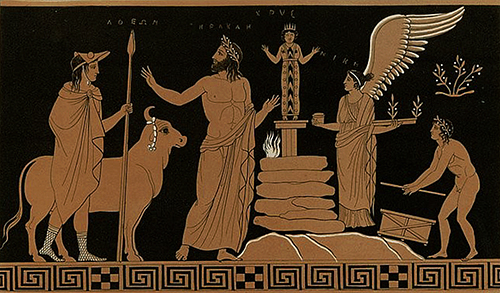
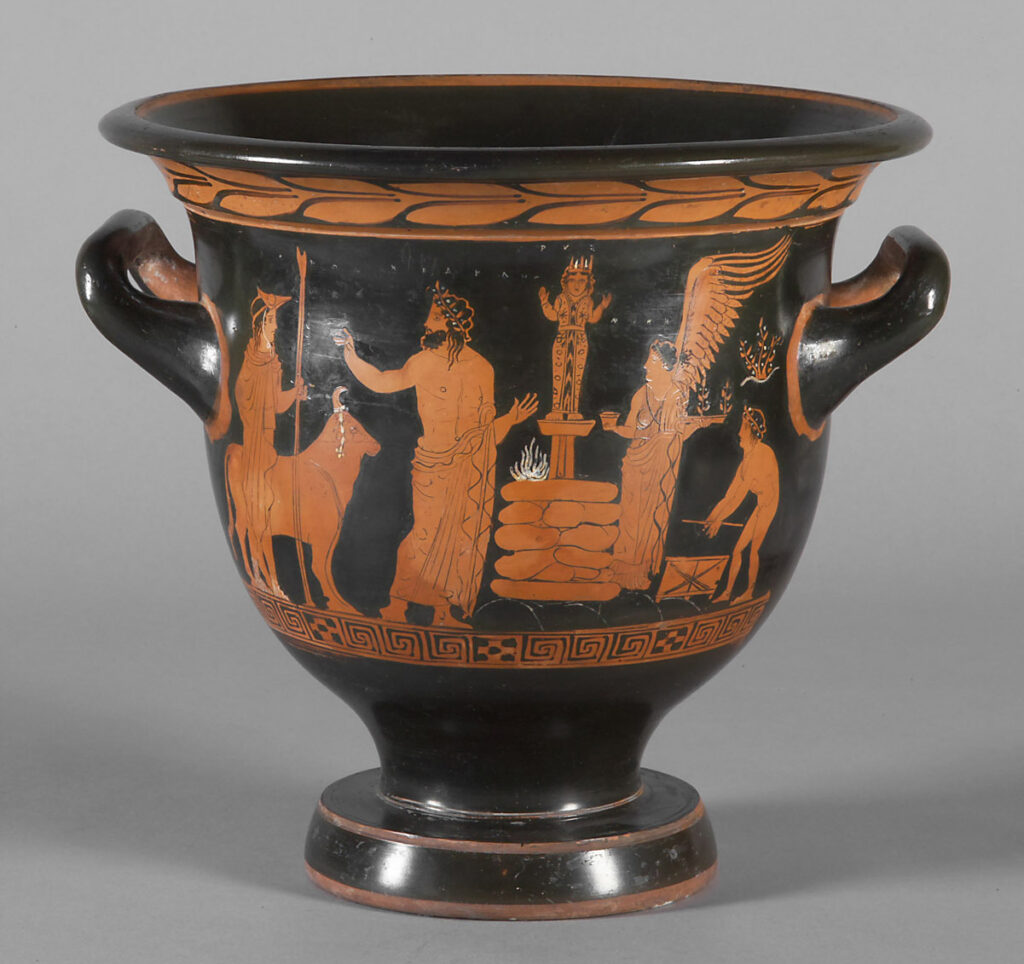
§1. In the picture I have just shown, to which I will hereafter refer short-hand as “Vienna 1144,” we see the goddess Chryse, visualized as a cult statue, presiding over the sacrifice of a bovine victim. In the previous essay (Nagy 2021.08.02, linked here), I showed a close-up of this same goddess in the same picture, where she is clearly identified as Chryse by way of the Greek lettering above her head (ΧΡΥΣΕ).
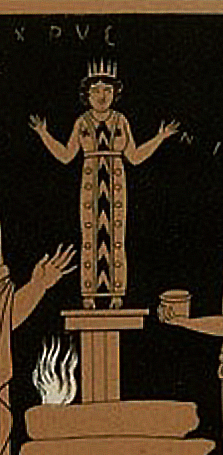
§2. And the same goddess presides over a different sacrifice as painted in another picture that I also showed in the previous essay (again, Nagy 2021.08.02, linked here). This picture, which I show here again, is a drawing that copies a painting on a vase housed in Paris, at the Louvre:
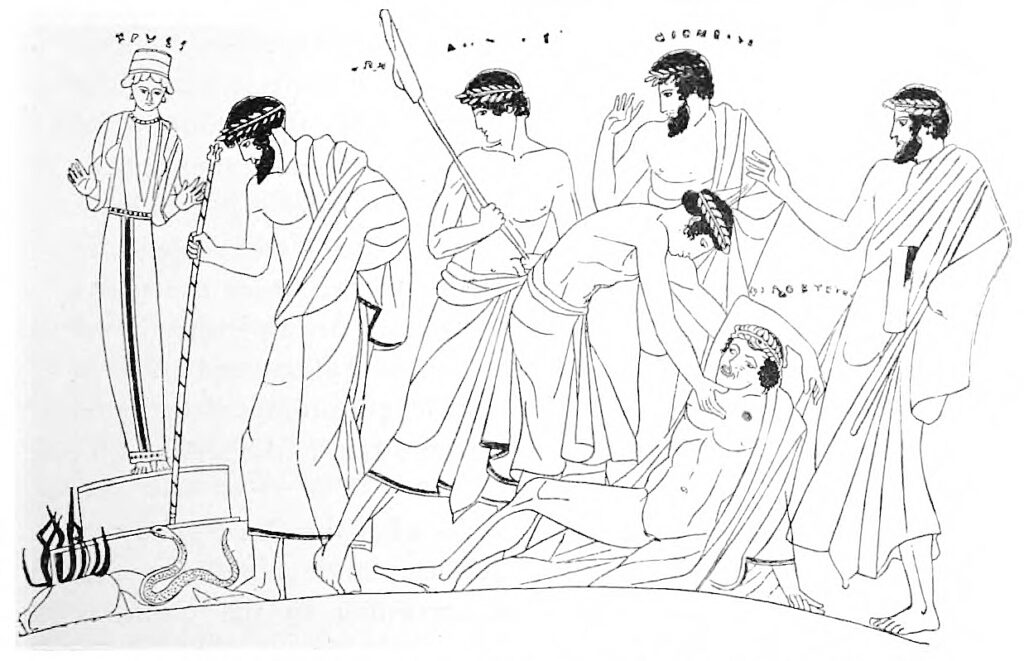
I repeat here what I said in the previous essay, at §5 there, about this picture, to which I will refer hereafter as “Louvre G 143.” The drawing that I have just shown derives, as I indicate in the caption, from Richard Jebb’s edition (1898) of the Philoctetes of Sophocles, with commentary, and the commentator adds his own interpretation of what we see being pictured in the original vase painting (Jebb p. 204):
The image of Chrysè stands in the open air on a low pedestal; just in front of it is a low and rude altar, with fire burning on it; close to this is the serpent, at which Agamemnon is striking with his sceptre, while the wounded Philoctetes lies on the ground, with Achilles and others around him.
§3. Jebb’s comment here duly takes note of the goddess Chryse (he spells her name Chrysè), whose cult statue is seen on our left, far to the left—and whose identity is made clear by the Greek lettering above her head (ΧΡΥΣΕ). The fire that is blazing next to her altar signals that a sacrifice to her has been attempted, but the snake next to the fire signals that the sacrifice has failed, and that Philoctetes, whose open mouth signals his cries of pain, excruciating pain, has already been bitten by the serpent. The presence of the heroes Agamemnon and Achilles at this scene, both of whom are labeled by adjacent lettering, indicates that this attempted sacrifice to Chryse is a prelude to the Trojan War as narrated in the Homeric Iliad. And, as I already noted in my previous essay, the wording of Sophocles in his Philoctetes actually refers to this goddess Chryse by name (lines 194 and 1327)—and to her island by the same name, Chryse (line 270). But there is a detail that is missing in the tragedy of Sophocles—a detail that is prominently displayed in the corresponding picture, Louvre G 143. That detail is the explicit visualization of Chryse as a cult statue. And I show here another such visualization, as painted on another vase that is housed at the Louvre. What we now see is a close-up from a line drawing, juxtaposed with a photograph of the actually attested fragments of the painting, to which I will refer hereafter as Louvre G 342:

§4. We have a problem here. The presence of a cult statue of Chryse in the two Louvre vase paintings G 143 and G 342, even though both these paintings are dated to the late fifth century BCE—perhaps late enough to postdate the relatively late première, in 411 BCE, of the tragedy Philoctetes by Sophocles—cannot be reconciled with the absence of any mention of such a statue in this tragedy. So, Sophocles cannot be the “source,” as it were, for visualizations of this cult statue in vase paintings.
§5. Such visualizations must have come from elsewhere. And the most plausible “source,” in the verbal arts, would have been a much earlier tragedy, the Philoctetes of Euripides, the première of which took place in 431 BCE (the information comes from “Argumentum 2” in the manuscript tradition for the Medea of Euripides, the première of which took place on the same occasion). A scenario for such a “source,” dated two decades before the première of the Sophoclean Philoctetes, has been offered by the art historian Edna M. Hooker (1950), and I quote here her formulation (p. 41): “It is quite likely that in the course of this play [by Euripides] Philoktetes described how, as a boy, he accompanied Herakles to the sanctuary of Chryse and how he subsequently visited it on his way to the Trojan War and was bitten by the snake; and it is possible that a vivid description was given of the sanctuary with its ancient altar and image.”
§6. In terms of this formulation, there were two visits by Philoctetes to the sacred island of Chryse. The myth about the second visit is of course well known, since it was foundational for the plot of the tragedy by Sophocles. But the myth about the first visit is hardly mentioned anywhere in ancient Greek texts that have survived to this day. I summarize here the essentials, derived mostly from three of the rare textual references to this myth (Philostratus Images 17.2; scholia for Sophocles Philoctetes 194; also “Argumentum 1” in the textual tradition of the drama). We learn from such textual sources that Herakles, before he engaged in the “First” Trojan War, sailed to the island of Chryse, together with heroes like the youthful Philoctetes, and, hoping for victory in the war, he sacrificed there to the goddess of the island. I should add that, even though the myth about this first visit is hardly known, it is connected with a set of very well-known myths about this “First” Trojan War, led by Herakles, as distinct from the “Second” Trojan War, led by Agamemnon. I have commented elsewhere on the pairing of these myths about the “First” and the “Second” Trojan Wars as depicted respectively in the sculptures of the East and West Pediments of the temple of “Aphaia” in Aegina, stemming from the early fifth century BCE (Nagy 2016.03.24 §14, linked here).
§7. The myth about the first visit of Philoctetes to Chryse, in the entourage of Herakles, who performed there a sacrifice of a bovine victim in hopes of achieving victory in the upcoming “First” Trojan War, is precisely what we see being pictured in “Vienna 1144”—to use again my short-hand way of referring to that painting. In “Vienna 1144,” as we look again at the drawing that I used as the cover illustration for this essay, we can see clearly that even the divine embodiment of victory, labeled as such, Nīkē, by the adjacent lettering (ΝΙΚΕ), is attending the sacrifice, standing next to the altar and assisting the chief sacrificer, Herakles, who is also assisted by the youthful heroes Iolaos and Philoctetes. I agree here with Edna Hooker (1950:37, 39), whose analysis makes it clear that not only Herakles but also Iolaos can surely be identified by the adjacent Greek letterings, barely visible in the painting, while the boy who is shown in the act of opening a casket—we see him at our right, far right—can just as surely be identified as Philoctetes. In the case of Philoctetes here, we find no adjacent lettering attached to the picture of the boy in “Vienna 1144,” but there is another painting, “London E 494,” dated as early as 430 BCE, which clearly shows the youthful Philoctetes, identified as such by adjacent Greek lettering (ΦΙΛΟ⟨Σ⟩ΚΕΤ[…]), and we see him here in the act of roasting sacrificial meat on a double spit, participating in a sacrifice at the altar of the cult statue of Chryse—a sacrifice attended by Herakles together with Philoctetes and with a second youth named Likhas (identified as ΛΙ[…]: Hooker p. 37). The youthful Likhas is also shown in another related painting that dates from the fifth century BCE, “Hermitage 43F,” where he is accompanied by another youth, who is most likely Philoctetes, in helping Herakles sacrifice a bovine victim to Chryse (Hooker p. 40). I mention here yet another painting that pictures the sacrifice, this one painted on a vase housed in Taranto (Museo Nazionale 52399; Hooker p. 35), where we see a closed casket placed directly in front of the altar of Chryse. This casket, as I will suggest in a few minutes, can be connected with the casket that we see being opened by the boy identified as Philoctetes in “Vienna 1144.”
§8. This review of surviving evidence from the visual art of vase painting shows that the cult statue of Chryse was in fact an integral part of the myth about the first visit of Philoctetes to the sacred island of Chryse. And the formulation of Edna Hooker (1950:41), where she traces this myth back to the Philoctetes of Euripides, seems to me validated by the evidence of the relevant paintings. But can we say that this drama of Euripides, which goes back to 431 BCE, was really the “source” of the myth? I have been using the word “source” here in a qualified way, within “scare quotes,” since I think there is no need to treat as “original” the Euripidean treatment of the myth.
§9. Rather, I propose that Euripides was part of the myth’s reception, just as the painters were part of its further reception. And I prefer not to use the word “source” in reconstructing such reception, since “source” implies a purely textual point of departure. And although I agree with Hooker (p. 41) when she says that “many vase painters of this period drew their inspiration from the theatre,” I need to qualify the word “inspiration” as well. For such painters, and even for the likes of Euripides, the “inspiration” can be interpreted flatly as a mere reading of texts. Instead, I think that their “inspiration” comes from myth as performed—whether verbally, as in the case of poetry, or even visually, as in the case of painting. Accordingly, when Hooker asks herself (p. 41) “whether there was an actual sanctuary of Chryse in existence” in the era of Euripides—and, we may add, of painters contemporaneous with this poet in the fifth century BCE—I think it is not enough to say that Euripides “derived the details from some earlier poet’s description and partly from his own imagination.” If we think of “derivation” in terms of reception, as I have been using the word, where myth is transmitted in performance, then there is no reason to worry, with Hooker (again, p. 41), whether Euripides “had any first-hand knowledge of the sanctuary itself.”
§10. Euripides had a flair for anthropological inquiry, as I showed in another essay (Nagy 2021.02.20, linked here). And, as I suspect in the present case—not to mention many other cases—he had access to myths stemming from non-Athenian traditions, including the Aeolian traditions of Sappho’s homeland, the island of Lesbos. And here I pick up the common thread, as I described it in my previous essay (again, Nagy 2021.08.02, linked here), where I attempted to connect what was visualized by Athenian vase painters as the dress worn by the cult statue of Chryse with the Aeolian traditions of pattern-weaving as signaled by the meaning of the epithet poikiló-thronos, ‘wearing a patterned dress’—a meaning that graces the goddess Aphrodite in line 1 of Sappho’s Song 1. I can now pursue further such an attempt, in the light of the pictures I have surveyed in the present essay.
§11. The wording of Euripides—now no longer attested—where he would have described the dress of the cult statue of Chryse must have alluded, I suspect, to the art of pattern-weaving in the making of such a dress—and his wording may even have alluded to the style of patterns that were visualized in Song 1 of Sappho. This is not to say, however, that the Athenian painters who may have been “inspired” by such wording would have been able to replicate with any accuracy a visual representation of the pattern-woven dress worn by the cult statue guarding the altar for sacrificing bovine victims at the sacred island of Chryse. These Athenian painters would have been aware only of Athenian traditions of pattern-weaving, which would have been cognate with but hardly identical to the traditions of pattern-weaving native to the likes of Sappho. A case in point is the painting of Aphrodite that graces the cover illustration of an earlier essay of mine (Nagy 2021.07.26, linked here). I show again here that illustration:
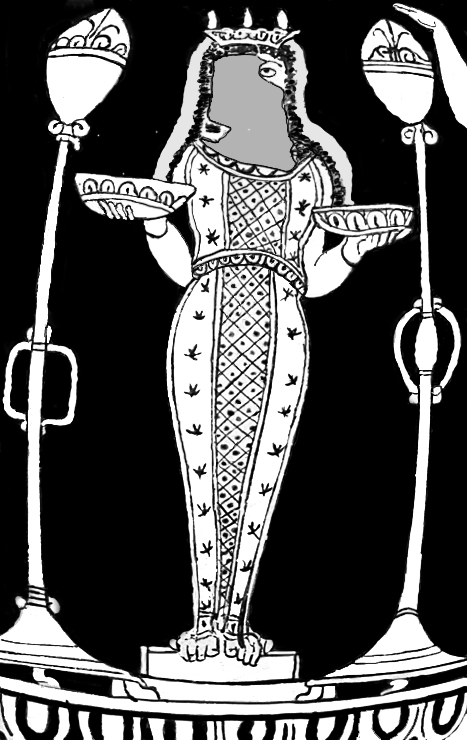
§12. The goddess Aphrodite here is certainly wearing a pattern-woven dress or peplos, and that certainty was reaffirmed for me when my friend Natasha Bershadsky and I consulted a mutual friend, Susan Edmunds, who is a celebrated expert in both the history and the practice of pattern-weaving. Susan has authorized me to share here her response to Natasha’s question: is the cult statue of Aphrodite here shown wearing a peplos decorated with floral patterns? I quote, with Susan’s permission, her response, written in a personal communication (2021.07.27): “And to Natasha’s question about the middle part of the peplos I can say that I am quite sure it would be possible to weave such a panel within a cloth that is also decorated with flowers—that is, it could be done on a warp-weighted loom by a skilled weaver.” It does not even matter, I should add, whether the patterns are really floral here—or astral. After all, Athenian traditions of representing Aphrodite as Ouraníā ‘sky-dwelling’ (as documented by Brita Alroth (2013 footnote 31, linked here) are compatible with representations of her peplos as decorated by stars as well as flowers.
§13. Relevant, I think, are two Athenian vase paintings (as shown by Brita Alroth 2013 in her open-access article, Figure 12 and Figure 13, linked here and here) that show the goddess Aphrodite wearing a patterned dress in two different manifestations of her divinity. One manifestation is her cult statue, as seen presiding over her altar, but the other manifestation is the goddess in person, as seen lounging seductively at the site of the same altar. I should note, however, that the myth about Aphrodite in these two paintings, centering on the abduction of the daughters of Leukippos, is different from the myth about Chryse in the paintings that are now under consideration.
§14. I cannot bring this essay to a close without asking an open-ended question—about the presence of Chryse as a goddess presiding over an altar guarded by a snake. My question, which I cannot yet answer, has to do with the casket that we see being opened by the boy identified as Philoctetes in the first vase painting that I showed in this essay. Here, then is the question: was there something inside the casket that was being opened? In another vase painting that I have also already noted, we see another such casket—this one is closed shut—and it has been placed at the base of the altar sacred to Chryse. When he visited the sanctuary of Chryse the first time, in the entourage of Herakles, Philoctetes perhaps opened a casket containing a snake, releasing it to guard the sacred ground of the goddess—to guard it from future would-be sacrificers whose motives were unholy. And perhaps, when Philoctetes visited the same sanctuary of Chryse the second time, now in the entourage of Agamemnon, something went wrong, very wrong this time. When he set foot on the sacred ground of the goddess, Philoctetes was now bitten by the snake—a snake he may have once upon a time released from its casket to guard against sacrificers who dare to approach the goddess with unholy motives.
Bibliography
Alroth, B. [1992] 2013. “Changing Modes in the Representation of Cult Images.” In The Iconography of Greek Cult in the Archaic and Classical Periods, ed. R. Hägg. Liège. https://books.openedition.org/pulg/185.
Heinrich, K. B. 1839. De Chryse insula et dea in Philoctete Sophoclis. Bonn.
Hooker, E. M. 1950. “The Sanctuary and Altar of Chryse in Attic Red-Figure Vase-Paintings of the Late Fifth and Early Fourth Centuries B. C.” Journal of Hellenic Studies 70:35-41.
Jebb, R. C., ed. 1898. Philoctetes. Cambridge.
Nagy, G. 2016.03.24. “Things noted during five days of travel study in Greece, 2016.03.13–18.” Classical Inquiries. https://classical-inquiries.chs.harvard.edu/things-noted-during-five-days-of-travel-study-2016-03-13-18/.
Nagy, G. 2016.10.08. “Sappho and mythmaking in the context of an Aeolian-Ionian Sprachbund.” Classical Inquiries. https://classical-inquiries.chs.harvard.edu/sappho-and-mythmaking-in-the-context-of-an-aeolian-ionian-poetic-sprachbund/.
Nagy, G. 2019. “A ritualized rethinking of what it meant to be ‘European’ for ancient Greeks of the post-heroic age: evidence from the Heroikos of Philostratus.” In Thinking the Greeks: A Volume in Honour of James M. Redfield, ed. B. M. King and L. Doherty, 173–187. London and New York. https://chs.harvard.edu/curated-article/gregory-nagy-a-ritualized-rethinking-of-what-it-meant-to-be-european-for-ancient-greeks-of-the-post-heroic-age-evidence-from-the-heroikos-of-philostratus/.
Nagy, G. 2021.02.20. “About Euripides the anthropologist, and how he reads the troubled thoughts of female initiands.” Classical Inquiries. https://classical-inquiries.chs.harvard.edu/euripides-the-anthropologist-and-his-imaginings-about-wandering-minds-of-female-initiands/.
Nagy, G. 2021.07.19. “Can Sappho be freed from receivership? Part One.” Classical Inquiries. https://classical-inquiries.chs.harvard.edu/can-sappho-be-freed-from-receivership-part-one/.
Nagy, G. 2021.07.26. “Can Sappho be freed from receivership? Part Two.” Classical Inquiries. https://classical-inquiries.chs.harvard.edu/can-sappho-be-freed-from-receivership-part-two/.
Nagy, G. 2021.08.02. “Sappho’s Aphrodite, the goddess Chryse, and a primal ordeal suffered by Philoctetes in a tragedy of Sophocles.” Classical Inquiries. https://classical-inquiries.chs.harvard.edu/sapphos-aphrodite-the-goddess-chryse-and-a-primal-ordeal-suffered-by-philoctetes-in-a-tragedy-of-sophocles/.
Pearson, A. C. 1889. The Fragments of Zeno and Cleanthes, with introduction and explanatory notes. Cambridge.
Tümpel, Karl. 1890. “Lesbiaka 2: Chryseïs-Apriate.” Philologus 49:89–120.


